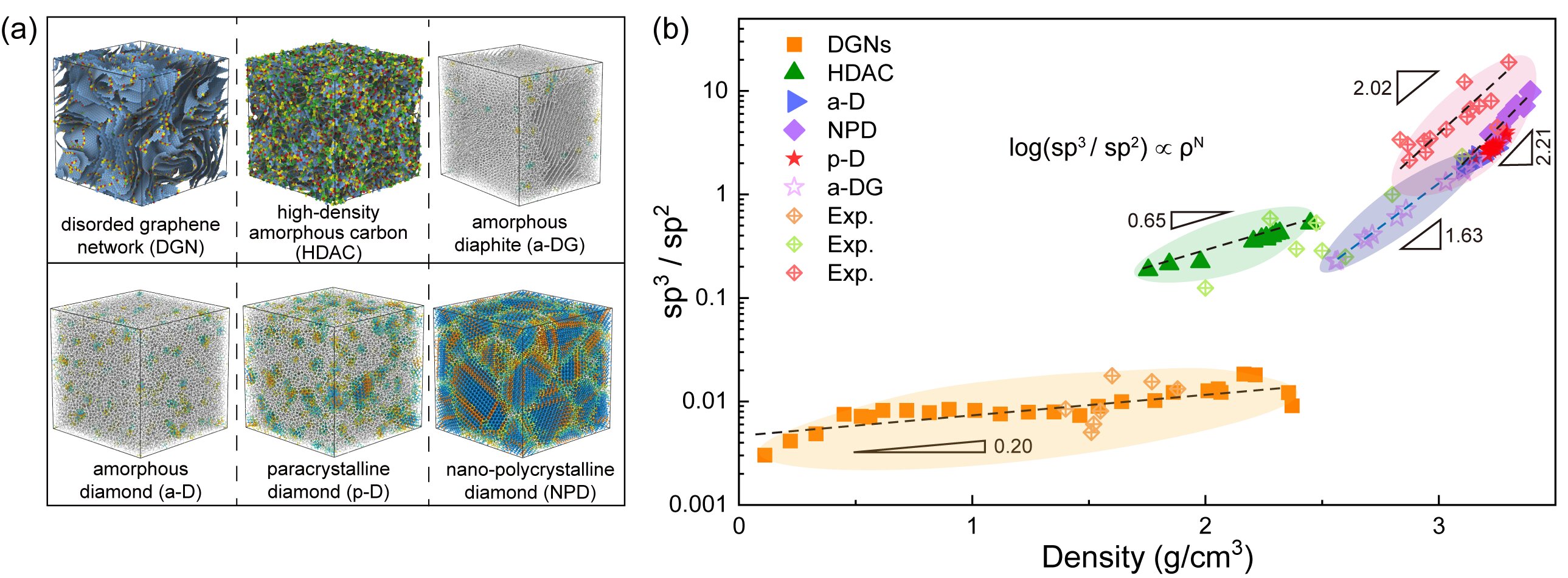Prof. Wu HengAn’s team from the University of Science and Technology of China has presented six representative phases of amorphous carbons based on large-scale molecular dynamics (MD) simulations, achieving a comprehensive microstructural landscape of amorphous carbons.
These phases include disordered graphene network (DGN), high-density amorphous carbon (HDAC), amorphous diaphite (a-DG), amorphous diamond (a-D), paracrystalline diamond (p-D), and nano-polycrystalline diamond (NPD), respectively. The team conducted a thorough analysis of the microstructural topological characteristics and their contributions to short- to medium-range order.
Notably, the a-DG exhibits hybrid features of amorphous graphite and atomically disordered diamond, while the p-D showcases numerous diamond-like nanonuclei distributed within an amorphous matrix.
Their microstructural topological characteristics bear a striking resemblance to the newly synthesized amorphous carbons in experiments, and this consistency suggests that the simulated models can effectively capture the various microstructures observed in experimentally prepared amorphous carbons.
Moreover, the team conducted a comprehensive analysis by comparing simulation data with experimental observations, leading to the development of a phase diagram in the sp3/sp2 versus the density plane.
The phase diagram revealed intriguing patterns characterized by unexpected discontinuities, which stem from inherent differences in the microstructural topology of various types of amorphous carbons. Interestingly, the team discovered a fitted power-law: log(sp3/sp2) ~ ρn, where different values of ‘n’ indicate that the microstructural stability of amorphous carbons can be regulated by manipulating the sp3/sp2 ratio under specific temperature-pressure conditions.
Despite significant variations in atomic-scale disorder resulting from changes in density, temperature, and pressure, it is still possible to distinguish different types of amorphous carbons through the short/medium range ordered topological microstructures. This classification approach paves the way for further investigations into the mechanical properties and other relevant attributes of amorphous carbons.
Furthermore, the researchers explored possible phase transition paths between different types of amorphous carbon based on the discontinuous phase diagram. They discovered that, by annealing DGN under high-temperature and high-pressure conditions, typical amorphous carbon structures such as a-DG, a-D, and p-D can be obtained. In addition, a reversible phase transition between DGN and HDAC was observed, consistent with recent first-principles calculations.
Therefore, there may be abundant yet undiscovered phase transitions and microstructural evolutions between different types of amorphous carbon under appropriate temperature-pressure conditions. The follow-up research goal is to investigate the mechanisms governing these phase transitions, providing valuable theoretical insights for the experimental synthesis of amorphous carbon materials.
The work is published in the journal National Science Review.
More information:
YinBo Zhu et al, Discontinuous phase diagram of amorphous carbons, National Science Review (2024). DOI: 10.1093/nsr/nwae051
Citation:
Imaging the microstructural landscape of amorphous carbons (2024, April 26)
retrieved 27 April 2024
from https://phys.org/news/2024-04-imaging-microstructural-landscape-amorphous-carbons.html
This document is subject to copyright. Apart from any fair dealing for the purpose of private study or research, no
part may be reproduced without the written permission. The content is provided for information purposes only.

